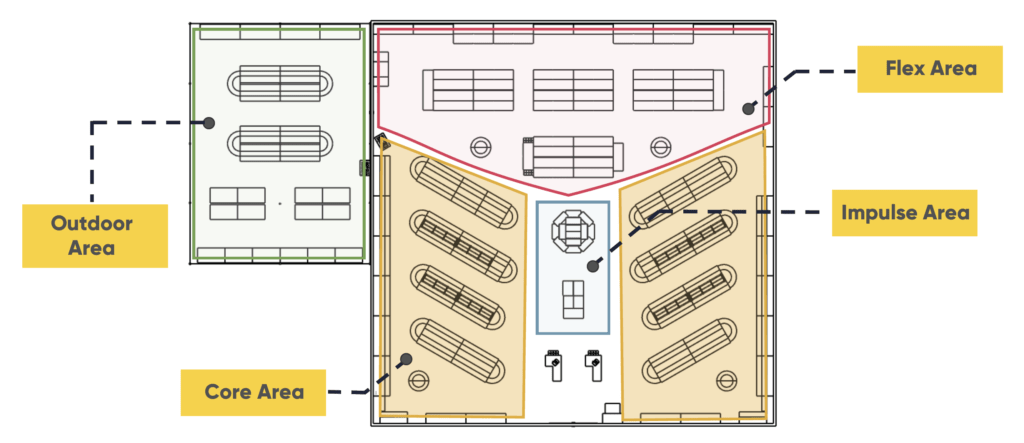How to Win Big with a Zone Layout Strategy
The idea of creating zones in a retail layout has been around forever, typically in the form of departments. Dividing a store into departments is widely accepted as a great way to provide “guideposts” to help customers find a product they are looking for quickly and easily. However, what if you were to start looking at zones a little differently? What if we used a strategy that broke down the store’s areas by merchandising strategy instead of departmental zones?
At SPC Retail®, we like to use a zone layout strategy when designing a store’s space. This strategy aims to identify areas of the store by determining how it will be utilized throughout the year. By approaching the design process this way, we can select the type of displays and fixtures each space will need based on the versatility desired to achieve a seasonal adaptation plan.
Let’s dive in and learn more about each zone and how to transition these spaces throughout the year effectively.
Zone Breakdown

Obviously, each retail space will look slightly different from the space used in the layout example above. However, we have found that most stores will have these four main area types incorporated into their layout in some form or fashion. The four zones include a core zone, impulse zone, flex zone, and outdoor zone.
Core Zone
The core zone is the area of your store that will stay consistent throughout the year. It will feature staples that your customers always need or be a place to promote your top-selling products. The idea is to provide a space for your constant inventory in both type and size. The displays you choose for this zone will generally be a semi-permanent to permanent installation and therefore won’t see many, if any, alterations in layout from season to season.
Impulse Zone
The impulse zone is one or more areas of your store that are ideal for prompting add-on sales, housing overstock, promoting featured products, or highlighting special deals. In our example above, this area sits in the aisleway near the checkout. However, an impulse zone could include the vestibule or decompression area near entrances, end-caps, or be its own section of the store. The impulse zone is intended to engage shoppers along their path through the store, eventually leading to impulse purchases. The displays you use in this zone must maintain a small footprint and be equipped to handle various product types since it’s likely to change drastically from season to season.
Flex Zone
The flex zone is the area of your store where you keep seasonal merchandise. Each season will call for different inventory and thematics such as signage, and therefore this zone needs to hold a high priority in your seasonal transition and adaptation strategy. Since the store’s flex area will get the most changes throughout the year, choosing a wide variety of display types that are modular and easy to move is essential.
Outdoor Zone
The outdoor zone is essentially a flex area in its own right and can be used similarly to the other zones types previously discussed. An outdoor space should be viewed as an extension of the sales floor. Therefore, it should deliver a shopping experience that provides the core products your customers expect, seasonal product overflow, or impulse and sale items. The displays used in this area need to withstand the outdoor elements, maximize merchandising capacity, and adequately showcase products.
Effective Seasonal Adaptation Strategy
Now that you understand the zone strategy, how does it play into a seasonal adaptation strategy? The answer is simple. By designing your store with versatility in mind, you’re able to effectively adapt your space quickly and efficiently as your merchandising needs change.
If you’ve ever heard the saying, “proper planning and preparation prevents poor performance,” then you know that the first step to any seasonal adaptation strategy is to create a plan. We can’t stress enough how determining your space’s layout strategy based on the types of products you will have on hand is important. That’s why we’ve developed a three-step process to help you plan and implement your seasonal changes using the zone layout strategy.
Step 1: Create a Plan of Action
Start by fact-finding and outlining all your wants and needs for each season. For example, what products will be in demand? Where should they go within your store layout? What layout or display changes need to be made to accommodate this merchandise? How much time will it take to make these changes? Are there things I can do now to prepare? By answering these questions, you’ll better understand the tasks that need to be completed and when.
Step 2: Start with Minor Changes
During the mid to late season, your focus should be on completing minor changes within each of your zones. For example, as products start selling out, condense them onto a single display or fill in any gaps. Small fixtures such as an impulse or flex display can be moved to a new location or merchanded with next season’s products. The idea is to do minor tasks that can be easily done during operating hours to help ease the burden during larger change-overs.
Step 3: The Final Touches
Shortly before a holiday or seasonal program is set to kick-off is when significant layout changes should happen. The flex zone is the area that will see the most significant changes during this stage. Typically, these changes will require moving larger displays, changing graphics and signage, and merchandising displays. It’s recommended that these types of changes occur during hours when the store is relatively empty or closed to avoid congestion in aisleways or inconvenience to shoppers.
Once you’ve mastered the three-step process and how it corresponds with each zone, you’ll be well on your way to achieving success with your seasonal adaptation strategies.
Is a zone layout strategy for you?
All retailers need to have a seasonal adaptation plan for their store. It keeps things fresh for the customer and provides a plan of action for dealing with seasonal merchandise. Utilizing a zone layout strategy as part of the seasonal adaptation plan is the ideal way to design your space for maximum versatility. This strategy will help dictate when and how to switch up aspects of your store while maintaining the recognizable flow your frequent customers have come to know.
To learn more about how to adapt your retail space from season to season, watch our recent webinar on Seasonal Adaptation.


